Catalyst 6500 Series Distributed Forwarding Card (DFC)/DFC3A Memory Upgrade Installation Note
Table of Contents
Catalyst 6500 Series Distributed Forwarding Card (DFC)/DFC3A Memory Upgrade Installation Note
Contents
Safety Overview
Required Tools
Verifying the DFC/DFC3A Memory
Removing the SODIMM
Installing the New SODIMM
Related Documentation
Obtaining Documentation
Catalyst 6500 Series Distributed Forwarding Card (DFC)/DFC3A Memory Upgrade Installation Note
Product numbers:
DFC: MEM-DFC-128M=, MEM-DFC-256M=, MEM-DFC-512M=
DFC3A: MEM-XCEF720-512M=
This publication provides procedures for installing memory on a Catalyst 6500 series Distributed Forwarding Card (DFC) and DFC3A.
Contents
This publication contains these sections:
Safety Overview
Safety warnings appear throughout this publication in procedures that, if performed incorrectly, may harm you. A warning symbol precedes each warning statement.
 |
Warning |
|
IMPORTANT SAFETY INSTRUCTIONS
This warning symbol means danger.
You are in a situation that could cause bodily injury. Before you work
on any equipment, be aware of the hazards involved with electrical circuitry
and be familiar with standard practices for preventing accidents. To
see translations of the warnings that appear in this publication, refer
to the translated safety warnings that
accompanied this device.
Note: SAVE THESE INSTRUCTIONS
Note: This documentation is to be used in conjunction
with the specific product installation guide that shipped with the product.
Please refer to the Installation Guide, Configuration Guide, or other
enclosed additional documentation for further details.
|
| Waarschuwing
|
BELANGRIJKE VEILIGHEIDSINSTRUCTIES
Dit waarschuwingssymbool betekent gevaar. U verkeert in een situatie
die lichamelijk letsel kan veroorzaken. Voordat u aan enige apparatuur
gaat werken, dient u zich bewust te zijn van de bij elektrische schakelingen
betrokken risico's en dient u op de hoogte te zijn van de standaard
praktijken om ongelukken te voorkomen. Voor een vertaling van de waarschuwingen
die in deze publicatie verschijnen, dient u de vertaalde veiligheidswaarschuwingen
te raadplegen die bij dit apparaat worden geleverd.
Opmerking BEWAAR DEZE INSTRUCTIES.
Opmerking Deze documentatie dient gebruikt te worden
in combinatie met de installatiehandleiding voor het specifieke product
die bij het product wordt geleverd. Raadpleeg de installatiehandleiding,
configuratiehandleiding of andere verdere ingesloten documentatie voor
meer informatie.
|
| Varoitus
|
T�RKEIT� TURVALLISUUTEEN LIITTYVI� OHJEITA
T�m� varoitusmerkki merkitsee vaaraa. Olet tilanteessa,
joka voi johtaa ruumiinvammaan. Ennen kuin ty�skentelet mink��n
laitteiston parissa, ota selv�� s�hk�kytkent�ihin
liittyvist� vaaroista ja tavanomaisista onnettomuuksien ehk�isykeinoista.
T�ss� asiakirjassa esitettyjen varoitusten k��nn�kset
l�yd�t laitteen mukana toimitetuista ohjeista.
Huomautus S�ILYT� N�M� OHJEET
Huomautus T�m� asiakirja on tarkoitettu k�ytett�v�ksi
yhdess� tuotteen mukana tulleen asennusoppaan kanssa. Katso lis�tietoja
asennusoppaasta, kokoonpano-oppaasta ja muista mukana toimitetuista
asiakirjoista.
|
| Attention
|
IMPORTANTES INFORMATIONS DE S�CURIT�
Ce symbole d'avertissement indique un danger. Vous vous trouvez
dans une situation pouvant causer des blessures ou des dommages corporels.
Avant de travailler sur un �quipement, soyez conscient des dangers
pos�s par les circuits �lectriques et familiarisez-vous
avec les proc�dures couramment utilis�es pour �viter
les accidents. Pour prendre connaissance des traductions d'avertissements
figurant dans cette publication, consultez les consignes de s�curit�
traduites qui accompagnent cet appareil.
Remarque CONSERVEZ CES INFORMATIONS
Remarque Cette documentation doit �tre utilis�e
avec le guide sp�cifique d'installation du produit qui accompagne
ce dernier. Veuillez vous reporter au Guide d'installation, au Guide
de configuration, ou � toute autre documentation jointe pour
de plus amples renseignements.
|
| Warnung
|
WICHTIGE SICHERHEITSANWEISUNGEN
Dieses Warnsymbol bedeutet Gefahr. Sie befinden sich in einer Situation,
die zu einer K�rperverletzung f�hren k�nnte. Bevor Sie
mit der Arbeit an irgendeinem Ger�t beginnen, seien Sie sich der
mit elektrischen Stromkreisen verbundenen Gefahren und der Standardpraktiken
zur Vermeidung von Unf�llen bewusst. �bersetzungen der in
dieser Ver�ffentlichung enthaltenen Warnhinweise sind im Lieferumfang
des Ger�ts enthalten.
Hinweis BEWAHREN SIE DIESE SICHERHEITSANWEISUNGEN AUF
Hinweis Dieses Handbuch ist zum Gebrauch in Verbindung
mit dem Installationshandbuch f�r Ihr Ger�t bestimmt, das
dem Ger�t beiliegt. Entnehmen Sie bitte alle weiteren Informationen
dem Handbuch (Installations- oder Konfigurationshandbuch o. �.)
f�r Ihr spezifisches Ger�t.
|
| Figyelem!
|
FONTOS BIZTONS�GI EL��R�SOK
Ez a figyelmezet� jel vesz�lyre utal. S�r�l�svesz�lyt
rejt� helyzetben van. Miel�tt b�rmely berendez�sen
munk�t v�gezte, legyen figyelemmel az elektromos �ramk�r�k
okozta kock�zatokra, �s ismerkedjen meg a szok�sos
balesetv�delmi elj�r�sokkal. A kiadv�nyban
szerepl� figyelmeztet�sek ford�t�sa a k�sz�l�khez
mell�kelt biztons�gi figyelmeztet�sek k�z�tt
tal�lhat�.
Megjegyz�s �RIZZE MEG EZEKET AZ UTAS�T�SOKAT!
Megjegyz�s Ezt a dokument�ci�t
a k�sz�l�khez mell�kelt �zembe helyez�si
�tmutat�val egy�tt kell haszn�lni. Tov�bbi
tudnival�k a mell�kelt �zembe helyez�si �tmutat�ban
(Installation Guide), Konfigur�ci�s �tmutat�ban
(Configuration Guide) vagy m�s dokumentumban tal�lhat�k.
|
| Avvertenza
|
IMPORTANTI ISTRUZIONI SULLA SICUREZZA
Questo simbolo di avvertenza indica un pericolo. La situazione
potrebbe causare infortuni alle persone. Prima di intervenire su qualsiasi
apparecchiatura, occorre essere al corrente dei pericoli relativi ai
circuiti elettrici e conoscere le procedure standard per la prevenzione
di incidenti. Per le traduzioni delle avvertenze riportate in questo
documento, vedere le avvertenze di sicurezza che accompagnano questo
dispositivo.
Nota CONSERVARE QUESTE ISTRUZIONI
Nota La presente documentazione va usata congiuntamente
alla guida di installazione specifica spedita con il prodotto. Per maggiori
informazioni, consultare la Guida all'installazione, la Guida alla configurazione
o altra documentazione acclusa.
|
| Advarsel
|
VIKTIGE SIKKERHETSINSTRUKSJONER
Dette varselssymbolet betyr fare. Du befinner deg i en situasjon
som kan for�rsake personskade. F�r du utf�rer arbeid
med utstyret, b�r du v�re oppmerksom p� farene som
er forbundet med elektriske kretssystemer, og du b�r v�re
kjent med vanlig praksis for � unng� ulykker. For �
se oversettelser av advarslene i denne publikasjonen, se de oversatte
sikkerhetsvarslene som f�lger med denne enheten.
Merk TA VARE P� DISSE INSTRUKSJONENE
Merk Denne dokumentasjonen skal brukes i forbindelse
med den spesifikke installasjonsveiledningen som fulgte med produktet.
Vennligst se installasjonsveiledningen, konfigureringsveiledningen eller
annen vedlagt tilleggsdokumentasjon for detaljer.
|
| Aviso
|
INSTRU��ES IMPORTANTES DE SEGURAN�A
Este s�mbolo de aviso significa perigo. O utilizador encontra-se
numa situa��o que poder� ser causadora de les�es
corporais. Antes de iniciar a utiliza��o de qualquer equipamento,
tenha em aten��o os perigos envolvidos no manuseamento
de circuitos el�ctricos e familiarize-se com as pr�ticas
habituais de preven��o de acidentes. Para ver tradu��es
dos avisos inclu�dos nesta publica��o, consulte
os avisos de seguran�a traduzidos que acompanham este dispositivo.
Nota GUARDE ESTAS INSTRU��ES
Nota Esta documenta��o destina-se a ser
utilizada em conjunto com o manual de instala��o inclu�do
com o produto espec�fico. Consulte o manual de instala��o,
o manual de configura��o ou outra documenta��o
adicional inclusa, para obter mais informa��es.
|
| �Advertencia!
|
INSTRUCCIONES IMPORTANTES DE SEGURIDAD
Este s�mbolo de aviso indica peligro. Existe riesgo para
su integridad f�sica. Antes de manipular cualquier equipo, considere
los riesgos de la corriente el�ctrica y familiar�cese
con los procedimientos est�ndar de prevenci�n de accidentes.
Vea las traducciones de las advertencias que acompa�an a este
dispositivo.
Nota GUARDE ESTAS INSTRUCCIONES
Nota Esta documentaci�n est� pensada para
ser utilizada con la gu�a de instalaci�n del producto
que lo acompa�a. Si necesita m�s detalles, consulte la
Gu�a de instalaci�n, la Gu�a de configuraci�n
o cualquier documentaci�n adicional adjunta.
|
| Varning!
|
VIKTIGA S�KERHETSANVISNINGAR
Denna varningssignal signalerar fara. Du befinner dig i en situation
som kan leda till personskada. Innan du utf�r arbete p� n�gon
utrustning m�ste du vara medveten om farorna med elkretsar och
k�nna till vanliga f�rfaranden f�r att f�rebygga
olyckor. Se �vers�ttningarna av de varningsmeddelanden som
finns i denna publikation, och se de �versatta s�kerhetsvarningarna
som medf�ljer denna anordning.
OBS! SPARA DESSA ANVISNINGAR
OBS! Denna dokumentation ska anv�ndas i samband
med den specifika produktinstallationshandbok som medf�ljde produkten.
Se installationshandboken, konfigurationshandboken eller annan bifogad
ytterligare dokumentation f�r n�rmare detaljer.
|
|

|

|
|

|

|
|

|

|
 |
Warning Only trained
and qualified personnel should be allowed to install, replace, or service
this equipment. |
Required Tools
These tools are required to upgrade the memory on the Catalyst 6500 series DFC or DFC3A:
- 3/16-inch flat-blade screwdriver for the captive installation screws on the module on which the DFC or DFC3A is installed
- Antistatic mat or antistatic foam
- Your own ESD-prevention equipment or the disposable grounding wrist strap included with all upgrade kits, field-replaceable units (FRUs), and spares
 |
Caution Always
use an ESD wrist strap when handling modules or coming into contact with
internal components. |
Verifying the DFC/DFC3A Memory
The Catalyst 6500 series DFC has a default memory configuration of 128 MB with Error Checking and Correction (ECC) (single-bit error detection and correction; 2-bit error detection) and is upgradeable to 256-MB ECC or 512-MB ECC.
The Catalyst 6500 series DFC3A has a default memory configuration of 512 MB double data rate (DDR) with ECC.
To verify the memory configuration on the DFC or DFC3A, enter the remote command module mod show memory summary command, where mod is the module with an installed DFC or DFC3A. Add the processor and I/O totals to get the total memory for the DFC or DFC3A.
This example shows how to check the total memory on the DFC on a fabric-enabled module in slot 9:
Router# remote command module 9 show memory summary
Head Total(b) Used(b) Free(b) Lowest(b) Largest(b)
Processor 31C5BFC0 205144128 127792712 77351416 65520524 64818696
I/O E000000 33554440 5987288 27567152 27567152 27567100
This example shows the total memory on the DFC is 256 MB.
Removing the SODIMM
 |
Caution During
this procedure, wear grounding wrist straps to avoid ESD damage to the card.
Do not directly touch the backplane with your hand or any metal tool, or
you could shock yourself. |
To remove the existing SODIMM, follow these steps:
Step 1 Make sure that you take the necessary precautions to prevent ESD damage.
Step 2 Remove the module with the DFC or DFC3A from the system. (Refer to the Catalyst 6500 Series Module Installation Guide for removal instructions.)
Step 3 Place the module on an antistatic mat or pad.
Step 4 Locate the SODIMM. (See Figure 1 for the DFC and Figure 2 for the DFC3A.)
Figure 1 Location of SODIMM on a DFC
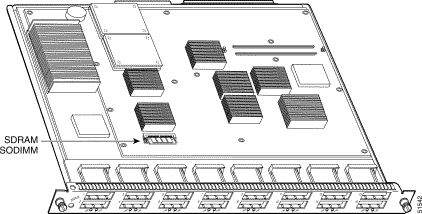
Figure 2 Location of SODIMM on a DFC3A
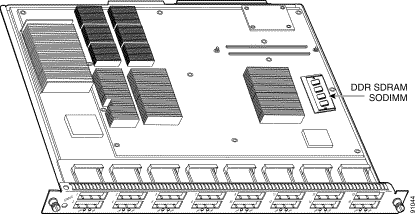
Step 5 Release the spring clips from the SODIMM, and release the SODIMM from the socket. (See Figure 3.)
Figure 3 Releasing the SODIMM Spring Clips
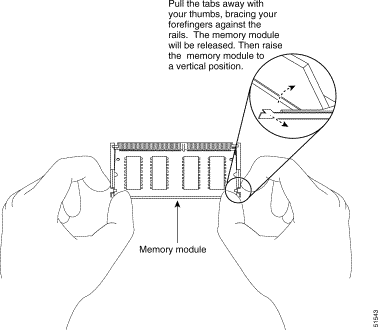
Step 6 When both ends of the SODIMM are released from the socket, grasp the ends of the SODIMM with your thumb and forefinger and pull the SODIMM completely out of the socket.
 |
Caution SODIMMs
are sensitive components that are susceptible to ESD damage. To prevent
ESD damage, handle SODIMMs by the edges only; avoid touching the memory
modules, pins, or traces (the metal fingers
along the connector edge of the SODIMM). (See Figure 4.) |
Step 7 Place the SODIMM in an antistatic container to protect it from ESD damage.
This completes the SODIMM removal procedure. Proceed to the next section to install the new SODIMM.
Installing the New SODIMM
 |
Caution SODIMMs
are sensitive components that are susceptible to ESD damage. To prevent
ESD damage, handle SODIMMs by the edges only; avoid touching the memory
modules, pins, or traces (the metal fingers
along the connector edge of the SODIMM). (See Figure 4.) |
Figure 4 Handling a SODIMM
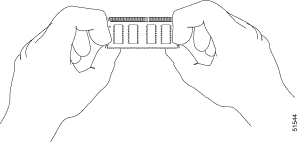
Follow these steps to install the new SODIMM:
Step 1 Remove a new SODIMM from the antistatic container.
Step 2 Hold the SODIMM component side up, with the connector edge (the metal fingers) away from you.
Step 3 Hold the sides of the SODIMM between your thumbs and forefingers. (See Figure 4.)
Step 4 Tilt the SODIMM to approximately the same angle as the socket, and insert the connector edge into the socket.
 |
Caution When
inserting SODIMMs, use firm but not excessive pressure. If you damage a
socket, you will have to return the DFC or DFC3A to the factory for repair. |
Step 5 Press the SODIMM down until it is secured by the spring clips. (See Figure 5.)
Figure 5 Installing the SODIMM
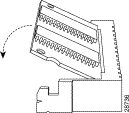
Step 6 When the SODIMM is installed, check the two alignment holes and ensure that the spring retainer is visible. If it is not, the SODIMM is not seated properly. If any SODIMM appears misaligned, carefully remove it and reseat it in the socket. Push the SODIMM firmly back into the socket until the retainer springs snap into place.
Step 7 Reinstall the module. (Refer to the Catalyst 6500 Series Module Installation Guide for removal instructions.)
Related Documentation
These documents are available for the Catalyst 6500 series switches:
- Regulatory Compliance and Safety Information for the Catalyst 6500 Series Switches
- Catalyst 6500 Series Installation Guide
- Catalyst 6500 Series Module Installation Guide
- Catalyst 6500 Series Software Configuration Guide
- Catalyst 6500 Series Command Reference
- Catalyst 6500 Series IOS Software Configuration Guide
- Catalyst 6500 Series IOS Command Reference
- Catalyst 6500 Series DFC/DFC3A Installation Note
Obtaining Documentation
Cisco provides several ways to obtain documentation, technical assistance, and other technical resources. These sections explain how to obtain technical information from Cisco Systems.
Cisco.com
You can access the most current Cisco documentation on the World Wide Web at this URL:
http://www.cisco.com/univercd/home/home.htm
You can access the Cisco website at this URL:
http://www.cisco.com
International Cisco web sites can be accessed from this URL:
http://www.cisco.com/public/countries_languages.shtml
Documentation CD-ROM
Cisco documentation and additional literature are available in a Cisco Documentation CD-ROM package, which may have shipped with your product. The Documentation CD-ROM is updated monthly and may be more current than printed documentation. The CD-ROM package is available as a single unit or through an annual subscription.
Registered Cisco.com users can order the Documentation CD-ROM (product number DOC-CONDOCCD=) through the online Subscription Store:
http://www.cisco.com/go/subscription
Ordering Documentation
You can find instructions for ordering documentation at this URL:
http://www.cisco.com/univercd/cc/td/doc/es_inpck/pdi.htm
You can order Cisco documentation in these ways:
- Registered Cisco.com users (Cisco direct customers) can order Cisco product documentation from the Networking Products MarketPlace:
http://www.cisco.com/en/US/partner/ordering/index.shtml
- Registered Cisco.com users can order the Documentation CD-ROM (Customer Order Number DOC-CONDOCCD=) through the online Subscription Store:
http://www.cisco.com/go/subscription
- Nonregistered Cisco.com users can order documentation through a local account representative by calling Cisco Systems Corporate Headquarters (California, U.S.A.) at 408 526-7208 or, elsewhere in North America, by calling 800 553-NETS (6387).
Documentation Feedback
You can submit comments electronically on Cisco.com. On the Cisco Documentation home page, click Feedback at the top of the page.
You can e-mail your comments to [email protected].
You can submit your comments by mail by using the response card behind the front cover of your document or by writing to the following address:
Cisco Systems
Attn: Customer Document Ordering
170 West Tasman Drive
San Jose, CA 95134-9883
We appreciate your comments.
Obtaining Technical Assistance
Cisco provides Cisco.com, which includes the Cisco Technical Assistance Center (TAC) Website, as a starting point for all technical assistance. Customers and partners can obtain online documentation, troubleshooting tips, and sample configurations from the Cisco TAC website. Cisco.com registered users have complete access to the technical support resources on the Cisco TAC website, including TAC tools and utilities.
Cisco.com
Cisco.com offers a suite of interactive, networked services that let you access Cisco information, networking solutions, services, programs, and resources at any time, from anywhere in the world.
Cisco.com provides a broad range of features and services to help you with these tasks:
- Streamline business processes and improve productivity
- Resolve technical issues with online support
- Download and test software packages
- Order Cisco learning materials and merchandise
- Register for online skill assessment, training, and certification programs
To obtain customized information and service, you can self-register on Cisco.com at this URL:
http://www.cisco.com
Technical Assistance Center
The Cisco TAC is available to all customers who need technical assistance with a Cisco product, technology, or solution. Two levels of support are available: the Cisco TAC website and the Cisco TAC Escalation Center. The avenue of support that you choose depends on the priority of the problem and the conditions stated in service contracts, when applicable.
We categorize Cisco TAC inquiries according to urgency:
- Priority level 4 (P4)�You need information or assistance concerning Cisco product capabilities, product installation, or basic product configuration.
- Priority level 3 (P3)�Your network performance is degraded. Network functionality is noticeably impaired, but most business operations continue.
- Priority level 2 (P2)�Your production network is severely degraded, affecting significant aspects of business operations. No workaround is available.
- Priority level 1 (P1)�Your production network is down, and a critical impact to business operations will occur if service is not restored quickly. No workaround is available.
Cisco TAC Website
You can use the Cisco TAC website to resolve P3 and P4 issues yourself, saving both cost and time. The site provides around-the-clock access to online tools, knowledge bases, and software. To access the Cisco TAC website, go to this URL:
http://www.cisco.com/tac
All customers, partners, and resellers who have a valid Cisco service contract have complete access to the technical support resources on the Cisco TAC website. Some services on the Cisco TAC website require a Cisco.com login ID and password. If you have a valid service contract but do not have a login ID or password, go to this URL to register:
http://tools.cisco.com/RPF/register/register.do
If you are a Cisco.com registered user, and you cannot resolve your technical issues by using the Cisco TAC website, you can open a case online at this URL:
http://www.cisco.com/en/US/support/index.html
If you have Internet access, we recommend that you open P3 and P4 cases through the Cisco TAC website so that you can describe the situation in your own words and attach any necessary files.
Cisco TAC Escalation Center
The Cisco TAC Escalation Center addresses priority level 1 or priority level 2 issues. These classifications are assigned when severe network degradation significantly impacts business operations. When you contact the TAC Escalation Center with a P1 or P2 problem, a Cisco TAC engineer automatically opens a case.
To obtain a directory of toll-free Cisco TAC telephone numbers for your country, go to this URL:
http://www.cisco.com/warp/public/687/Directory/DirTAC.shtml
Before calling, please check with your network operations center to determine the level of Cisco support services to which your company is entitled: for example, SMARTnet, SMARTnet Onsite, or Network Supported Accounts (NSA). When you call the center, please have available your service agreement number and your product serial number.
Obtaining Additional Publications and Information
Information about Cisco products, technologies, and network solutions is available from various online and printed sources.
- The Cisco Product Catalog describes the networking products offered by Cisco Systems as well as ordering and customer support services. Access the Cisco Product Catalog at this URL:
http://www.cisco.com/en/US/products/products_catalog_links_launch.html
- Cisco Press publishes a wide range of networking publications. Cisco suggests these titles for new and experienced users: Internetworking Terms and Acronyms Dictionary, Internetworking Technology Handbook, Internetworking Troubleshooting Guide, and the Internetworking Design Guide. For current Cisco Press titles and other information, go to Cisco Press online at this URL:
http://www.ciscopress.com
- Packet magazine is the Cisco monthly periodical that provides industry professionals with the latest information about the field of networking. You can access Packet magazine at this URL:
http://www.cisco.com/en/US/about/ac123/ac114/about_cisco_packet_magazine.html
- iQ Magazine is the Cisco monthly periodical that provides business leaders and decision makers with the latest information about the networking industry. You can access iQ Magazine at this URL:
http://business.cisco.com/prod/tree.taf%3fasset_id=44699&public_view=true&kbns=1.html
- Internet Protocol Journal is a quarterly journal published by Cisco Systems for engineering professionals involved in the design, development, and operation of public and private internets and intranets. You can access the Internet Protocol Journal at this URL:
http://www.cisco.com/en/US/about/ac123/ac147/about_cisco_the_internet_protocol_journal.html
- Training�Cisco offers world-class networking training, with current offerings in network training listed at this URL:
http://www.cisco.com/en/US/learning/le31/learning_recommended_training_list.html
This document is to be used in conjunction with the documents listed in the "Related Documentation" section.
|








